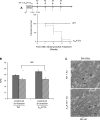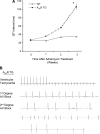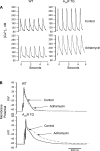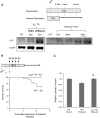Effects of cardiac-restricted overexpression of the A(2A) adenosine receptor on adriamycin-induced cardiotoxicity
- PMID: 20363887
- PMCID: PMC2886639
- DOI: 10.1152/ajpheart.00688.2009
Effects of cardiac-restricted overexpression of the A(2A) adenosine receptor on adriamycin-induced cardiotoxicity
Abstract
Activation of the A(2A) adenosine receptor (A(2A)R) has been shown to be cardioprotective. We hypothesized that A(2A)R overexpression could protect the heart from adriamycin-induced cardiomyopathy. Transgenic (TG) mice overexpressing the A(2A)R and wild-type mice (WT) were injected with adriamycin (5 mg.kg(-1).wk(-1) ip, 4 wk). All WT mice survived adriamycin treatment while A(2A)R TG mice suffered 100% mortality at 4 wk. Telemetry showed progressive prolongation of the QT interval, bradyarrhythmias, heart block, and sudden death in adriamycin-treated A(2A)R TG but not WT mice. Both WT and A(2A)R TG demonstrated similar decreases in heart function at 3 wk after treatment. Adriamycin significantly increased end-diastolic intracellular Ca(2+) concentration in A(2A)R TG but not in WT myocytes (P < 0.05). Compared with WT myocytes, action potential duration increased dramatically in A(2A)R TG myocytes (P < 0.05) after adriamycin treatment. Expression of connexin 43 was decreased in adriamycin treated A(2A)R TG but not WT mice. In sharp contrast, A(2A)R overexpression induced after the completion of adriamycin treatment resulted in no deaths and enhanced cardiac performance compared with WT adriamycin-treated mice. Our results indicate that the timing of A(2A)R activation is critical in terms of exacerbating or protecting adriamycin-induced cardiotoxicity. Our data have direct relevance on the clinical use of adenosine agonists or antagonists in the treatment of patients undergoing adriamycin therapy.
Figures





References
-
- Akar FG, Spragg DD, Tunin RS, Kass DA, Tomaselli GF. Mechanisms underlying conduction slowing and arrhythmogenesis in nonischemic dilated cardiomyopathy. Circ Res 95: 717–725, 2004 - PubMed
-
- Beardslee MA, Lerner DL, Tadros PN, Laing JG, Beyer EC, Yamada KA, Kleber AG, Schuessler RB, Saffitz JE. Dephosphorylation and intracellular redistribution of ventricular connexin43 during electrical uncoupling induced by ischemia. Circ Res 87: 656–662, 2000 - PubMed
-
- Bristow MR, Minobe WA, Billingham ME, Marmor JB, Johnson GA, Ishimoto BM, Sageman WS, Daniels JR. Anthracycline-associated cardiac and renal damage in rabbits. Evidence for mediation by vasoactive substances. Lab Invest 45: 157–168, 1981 - PubMed
-
- Buja LM, Ferrans VJ, Mayer RJ, Roberts WC, Henderson E. Cardiac ultrastnictural changes induced by daunorubicin therapy. Cancer 32: 771–778, 1973 - PubMed
-
- Chan TO, Funakoshi H, Song J, Zhang XQ, Wang J, Chung PH, Degeorge BR, Li X, Zhang J, Herrmann DE, Diamond M, Hamad E, Houser SR, Koch WJ, Cheung JY, Feldman AM. Cardiac-restricted overexpression of the A2A-adenosine receptor in FVB mice transiently increases contractile performance and rescues the heart failure phenotype in mice overexpressing the A1-adenosine receptor. Clin Transl Sci 1: 126–133, 2008 - PMC - PubMed
Publication types
MeSH terms
Substances
Grants and funding
LinkOut - more resources
Full Text Sources
Other Literature Sources
Medical
Molecular Biology Databases
Miscellaneous

